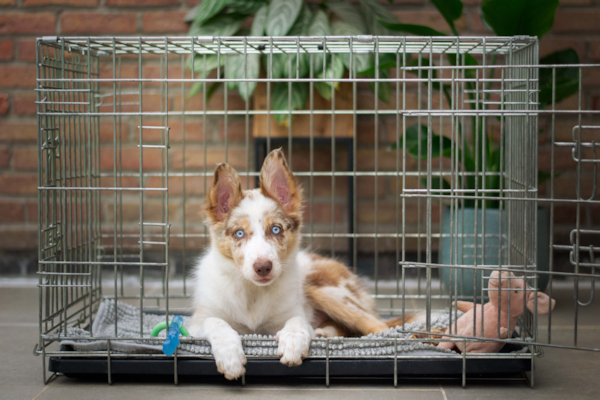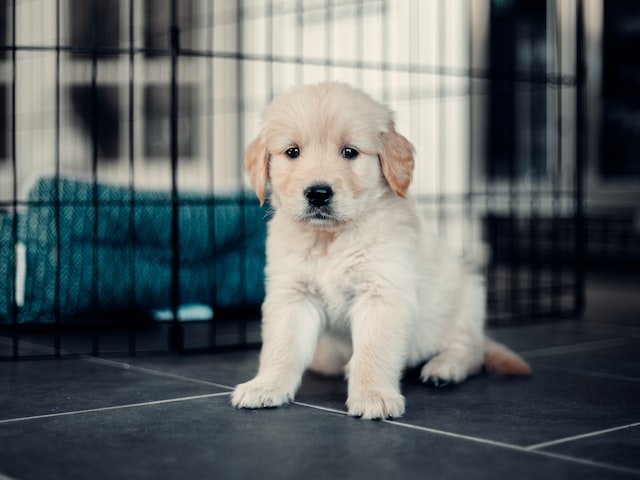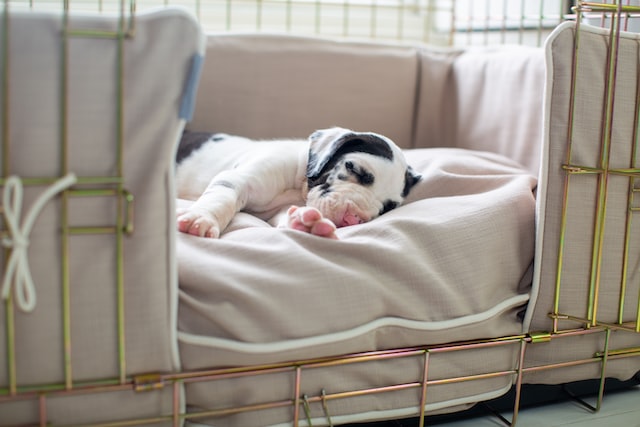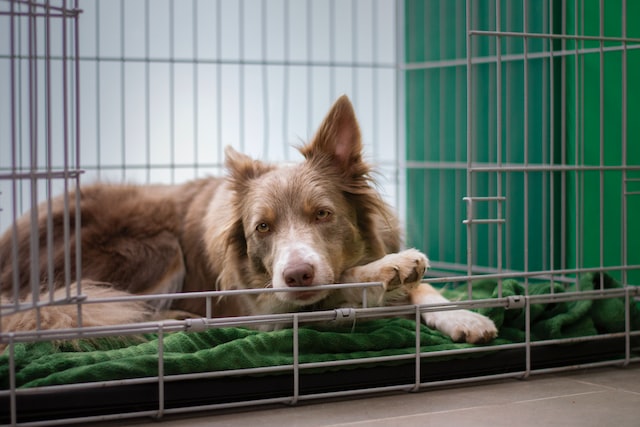
Crate training can be a lifesaver for both you and your puppy, not to mention your house. It can provide a safe space, a sanctuary for your puppy to rest and sleep, as well as a place for them to retreat to when they need a break from the hustle and bustle of the household. It can also be a helpful tool for house training, as puppies are naturally reluctant to go potty in their sleeping area.
It's important to remember that crate training is not a substitute for exercise, socialization, and training. Your puppy will still need plenty of opportunities to play, explore, and interact with you and other people and animals. Here are 4 easy steps to help you crate train your puppy.
Table of Contents
1. How To Choose The Best Crate Size For Your Dog

As a first step to crate training a puppy, you need to pick out a crate that is tailored to their size. When choosing a crate for your dog, it is important to select one that is the right size for their breed and age. A crate that is too small can be uncomfortable for your dog and may even cause them stress, while a crate that is too large may not provide the sense of security that a crate is meant to provide.
Here are some tips for selecting the right crate size for your dog:
- Measure your dog: Measure your dog from the tip of their nose to the base of their tail. This will give you an idea of how long the crate needs to be.
- Consider their breed: Different breeds have different size and shape requirements for their crate. For example, a crate for a small breed like a Yorkie will be much smaller than a crate for a larger breed like the Portuguese Water Dog.
- Consider their age: Puppies grow quickly, so you may need to purchase a larger crate as they grow. Make sure to purchase a crate that will be the right size for your dog when they are fully grown.
- Check the crate dimensions: Once you have an idea of the right size crate for your dog, check the dimensions of the crate to make sure it will be suitable. The crate should be long enough for your dog to stretch out, tall enough for them to stand up, and wide enough for them to turn around.
- Test it out: If possible, have your dog try out the crate before you make a purchase. This will give you a better idea of whether the crate is the right size and shape for your dog.
RELATED: Small Dogs Vs Big Dogs
2. Introducing The Crate

Next, introduce the crate gradually. Place the crate in a room where the puppy spends a lot of time, such as the living room or kitchen. Leave the door open and encourage the puppy to explore the crate on their own by leaving some delicious treats inside. Gradually increase the amount of time the puppy spends in the crate, starting with just a few minutes at a time and working up to longer periods.
As your puppy becomes more comfortable with the crate, start using it as a reward for good behavior. For example, give the puppy a treat and praise when they go into the crate willingly. Don't use the crate as punishment, as this can create negative associations with the crate.
Establishing a consistent routine is also key to successful crate training. Decide on a schedule for feeding, walking, and crate time, and stick to it as closely as you can. This will help the puppy understand when they can expect to be let out of the crate and when they will be expected to stay in it.
Crate training can be challenging, especially for puppies who are not used to being confined in small spaces. Be patient and consistent, and reward good behavior when it happens. If your puppy is having a hard time adjusting to the crate, consider providing them with a cozy crate cover or a plush crate pad to make their space more comfortable.
When the puppy is out of the crate, be sure to keep an eye on them and supervise their behavior. This will help prevent accidents and destructive behavior. If you can't be there to supervise, consider using a playpen or a baby gate to keep the puppy contained in a safe area.
Crate training is a useful and effective way to house-train puppies and provide them with a sanctuary of their own. By introducing the crate gradually, using it as a reward, establishing a consistent routine, and being patient, you can effectively crate train your puppy and set them up for success.
RELATED: New Puppy Owner Guide
3. How To Crate Train A Puppy At Night

Crate training a puppy at night can be a helpful way to manage their sleeping and potty-training needs. Most puppy owners opt to place the crate in their bedroom to help their puppies adjust easier.
When you are ready to start crate training at night, put your puppy in the crate when you go to bed. You may want to start with short periods of time and gradually increase the duration as your puppy gets used to being in the crate. Make sure the crate is comfortable, with a bed and plenty of ventilation. If your puppy cries or whines in the crate, try ignoring the behavior. They may cry for a little while, but eventually, they should settle down. Avoid letting them out of the crate if they cry, as this can reinforce the crying behavior.
If your puppy needs to use the bathroom during the night, take them outside to their designated bathroom area on a leash. Avoid playing with them or giving them attention until they go to the bathroom, as this can distract them from their goal. With consistent training, your puppy should be able to sleep through the night in their crate within a few weeks.
It's important to be patient and consistent with your crate training efforts. Crate training a puppy at night can take some time and effort, but it is well worth it in the end. Not only will it help with potty training, but it will also give your puppy a sense of security and a safe place to sleep.
RELATED: Top 10 Dog Training Mistakes To Avoid
4. How Long Does It Take To Crate Train A Puppy

The length of time it takes to crate train a puppy can vary depending on several factors, including the puppy's age, breed, and personality, as well as the consistency and patience of the person doing the training. On average, it may take anywhere from a few days to a few weeks to crate train a puppy.
Crate training a puppy is an important aspect of responsible pet ownership, as it can help with potty training, provide a sense of security and comfort, and establish a routine for sleeping and resting. The length of time it takes to crate train a puppy can vary depending on a number of factors.
One factor that can affect the length of time it takes to crate train a puppy is their age. Puppies younger than 12 weeks may have a harder time holding their bladder and may need to go outside more frequently, which can extend the crate training process. On the other hand, older puppies may have already developed some bladder control and may be able to go longer periods of time in the crate.
Another factor that can impact the crate training process is the breed of the puppy. Some breeds are more prone to separation anxiety and may take longer to adjust to being in a crate, while other breeds may be more independent and adapt more quickly.
The personality of the puppy can also be a factor in crate training. Some puppies may be more anxious and may take longer to feel comfortable in a crate, while others may be more confident and adapt more quickly.
Finally, the consistency and patience of the person doing the training can also play a role in the length of time it takes to crate train a puppy. It is important to be consistent in your training efforts and to be patient as the puppy adjusts to being in the crate. With patience, consistency, and the right training approach, most puppies can be crate trained within a few days to a few weeks.
RELATED: Week One With A New Puppy - What To Expect
Conclusion
In conclusion, crate training a puppy can be a helpful and effective way to manage their sleeping and potty training needs. It is important to choose a crate that is the right size for your puppy and to introduce the crate gradually in a positive manner. By using treats and praise to create a positive association with the crate, and by establishing a consistent schedule for feeding, watering, and taking the puppy out for potty breaks, you can help your puppy learn to love their crate and see it as a safe and comfortable place to be.
Remember to be patient and consistent in your crate training efforts, as every puppy is different and may take different amounts of time to adjust to being in a crate. With patience and consistency, most puppies can be crate trained within a few days to a few weeks. Crate training a puppy can take some time and effort, but it is well worth it in the end, as it can help with potty training, provide a sense of security and comfort, and establish a routine for sleeping and resting.
Scroll down to see FAQs about crate training a puppy!
What To Read Next
10 Reasons Why Dogs Lose Interest in Training & How to Fix it
15 Best Dog Breeds for First-Time Owners
Frequently Asked Questions
How much do puppies sleep? Puppies have a lot of energy and need plenty of sleep to help them grow and develop. In fact, puppies generally sleep for about 18-20 hours per day. This is because their bodies are growing and developing quickly, which requires a lot of energy. Puppies also have short attention spans and may tire easily, which can lead to more sleep.
Should puppies sleep in crates? Yes, it is generally recommended that puppies sleep in crates. A crate can provide a safe and secure place for your puppy to sleep and rest and can also be a helpful tool for potty training.
Should puppies nap in their crate during the day? It is a good idea for puppies to take naps in their crate during the day. The crate provides a comfortable place for them to rest and can also be beneficial for house training. Along with napping in their crate, it is essential to give puppies plenty of chances for exercise, play, and socialization throughout the day.
Is it OK to let a puppy cry in crate at night? It is generally not recommended to let a puppy cry in the crate at night. While it is normal for puppies to whine or cry when they are first placed in the crate, ignoring this behavior and letting them cry it out can lead to feelings of anxiety and distress. It is important to provide a safe and comfortable crate environment for your puppy, and to gradually acclimate them to the crate over time. If your puppy is crying excessively in the crate, it may be a sign that they need to use the bathroom or are experiencing separation anxiety. In these cases, it is important to address the underlying issue rather than letting the puppy cry it out.
How long should an 8-week-old puppy be in a crate An 8-week-old puppy can generally be in a crate for about 3-4 hours at a time. It is important to remember that puppies have small bladders and may need to use the bathroom more frequently, so they may need to be taken out to use the bathroom more often.




